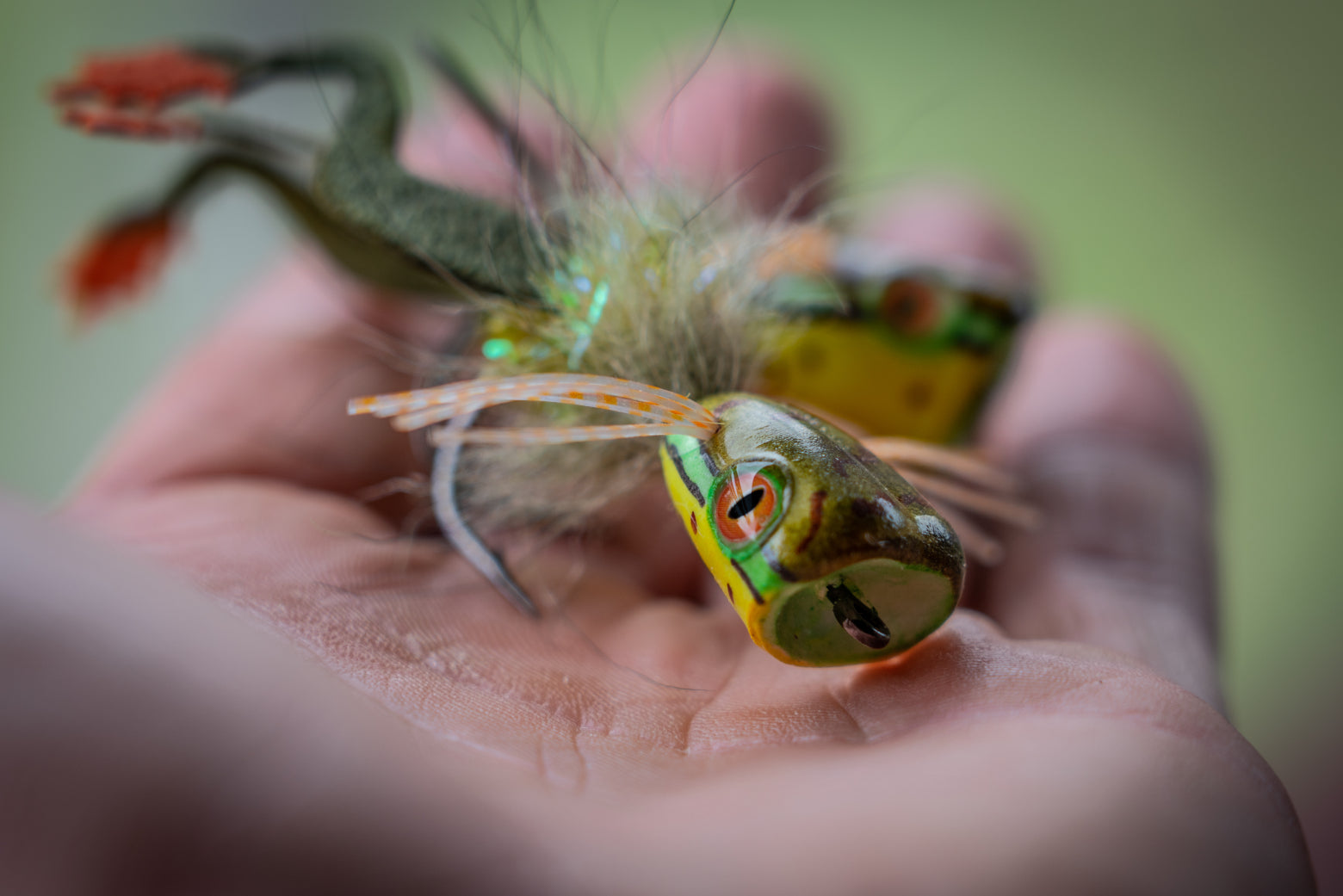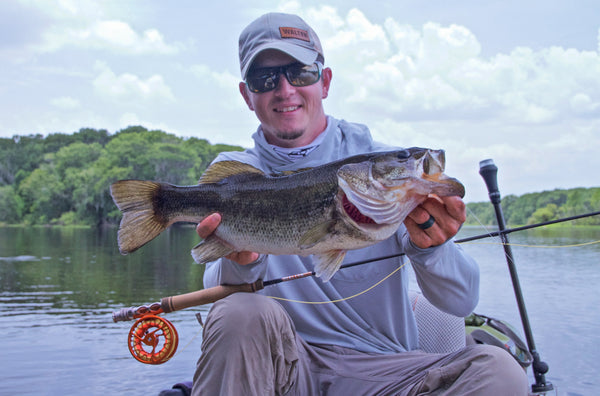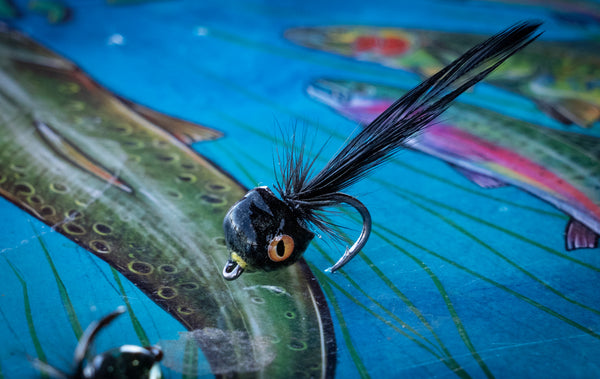Matching the Hatch with Tadpole and Frog Flies: Fly Fishing and Tying Tips


Ultimate Frog Popper tied with a Surface Seducer Double Barrel popper & slider body, Dragon Eyes, and a size 1/0 Kona Big Game Carnivore hook.
It is first light. You are sitting quietly and motionless in an aluminum canoe in the middle of a 10-acre pond full of lily pads trying not to make a sound.
You have spent the last 30 minutes of darkness listening to the insects and frogs begin to quiet down as the sun begins to rise. Thick fog permeates the still air and the water is still as glass.
Every 15 seconds you can hear a bass blow up on an unsuspecting victim. It is summertime now and frogs and tadpoles are one of the most readily available food sources in the lake... Too bad all you have in your box are Clousers, chenille worms, and crawdads. OOPS!

As a fly angler the scenario described above can be enough to cause one’s knees to shake with excitement. There is only one problem though – not having the right flies to capitalize on the action by “matching the hatch” can turn a potential 20-fish morning into a 5-fish day quite quickly.

I'm going to let you in on a few fly patterns, tips, and tricks that have helped me become successful at fishing topwater frog and tadpole patterns for bass in Florida. These tips and tricks will work anywhere that thick cover allows for a healthy frog population to exist.
Firstly, let's take a look at the lifecycle of a frog. Frogs begin their journey to becoming lunch for largemouth bass as a tiny egg. Next they then hatch into a tadpoles. Tadpoles typically stay in large schools tight up against structure or the bottom. Sometimes they can be seen on the surface as well. These little guys can vary greatly in size from .5 inches to about 3 to 4 inches depending on the species of frog. As they grow the tadpole begins to develop 2 legs, then 4 legs, and then loses its tail as it morphs into a young frog.
Fly Fishing Guide Tips: How to Prepare to Fish the Upper Midwest for Warm Water Species
I like to look at the frog lifecycle the same way trout fishermen look at the lifecycle of aquatic insects. Essentially the same way a nymph change into a healthy dry fly, these tadpoles change into frogs and therefore give the fly tyer a number of different ways to get creative and imitate this food source during different stages of its life.

For those of you that have never seen a tadpole fly here are some flies that I have developed that I have had great success on. These flies are about 1.25 inches in length and tied on a size #6 Kona Big Game Hunter hook.
One of the most overlooked fly patterns in the fly fishing world has been the tadpole.
Now I understand that watching a giant bass smoke a 4” fog popper or deer hair bug is a lot more adrenaline filled then twitching around a 1” tadpole fly; however, hopefully you will see where both can have their place during a day of fishing.

Surface Seducer Dragon Eyes finish off this tadpole fly pattern nicely.

One of these flies is made with a stacked foam head covered with UV Gel and allows the fly to sit on the surface of the water and be fished with very small ticktack strips. This imitates a tadpole perfectly and is easily smashed by bluegill as well as largemouth bass. Believe it or not, a big bass that may be too shy to hit that 4” frog will readily sip a slow-moving tadpole fly.

The other tadpole pattern that I throw has lead eyes and an epoxy head. I also incorporate 4 legs into this one that help imitate a tadpole that is farther along on his journey to becoming a frog. This fly can be deadly later on in the day when surface action has dwindled and the fish begin to focus their feeding efforts into deeper pockets of the lake.
Topwater Finesse Fly Fishing for Bass
For fishing tadpole flies I prefer to use 8lb test as the light line helps give the fly better action. The performance of small flies like these can easily be ruined by using too heavy of line. When fishing close to cover this may mean you lose a few fish here and there if they wrap up in the lily pads or into logs; however, I believe it is worth fishing the fly to the best of its ability and getting the eats.

Leaving the tadpoles behind, let's talk about frogs. If there was one thing about bass fishing that has taken over the internet in the past 4 to 5 years it is the slow-mo videos of bass absolutely destroying larger frog lures being cranked or popped across the surface. I’ll be honest, I have enjoyed many of those videos myself; and as a fly angler there is one fly pattern that has helped me live the epic experience of a gnarly topwater eat on plenty of occasions.
I like to call this fly the Ultimate Frog Popper. It has the exact appearance and silhouette of a real frog, which drives fish crazy. It sits on the surface of the water, pops, and is so real that hungry bass just can’t pass it up. I have even seen smaller fish come up and try to bite the legs off it one at a time.
The Ultimate Frog Popper tied with a Surface Seducer Double Barrel popper & slider body, Dragon Eyes, and a size 1/0 Kona Big Game Carnivore hook.
The secret to this fly is how to fish it. When I am fishing a large frog pattern I prefer to cast the fly into a pocket or breach in the structure where I feel bass are hiding. Once the fly hits the water you will want to wait about 5 seconds until the ripples have all gone away. Then give the fly 2-3 good pops and let it sit again until the ripples are all gone.
3 Tips to Catch More Smallmouth on the Fly
Because this fly has such a realistic nature in the water fish typically will hit it as it is sitting still between the popping sessions. This means that being alert and allowing the fly to have adequate time sitting motionless is key.
When fishing heavy grass, lily pads, or other structure with small pockets of open water I like to tie the fly with a titanium weed guard to help keep it weedless. In these scenarios you will want to throw the fly up into the cover and then wiggle it out of the grass or off the lily pad and so it leaps out into the open pocket of water. This is a great way to generate a strike from fish as well. Often frogs can be seen hopping from lily pad to lily pad or from reed to reed and often find themselves landing into the water by accident. This is the exact scenario that hungry bass are waiting for and where this fly really shines.

Hopefully these flies and techniques have given you a fresh look on a cool way to pick apart a bass pond. While classic subsurface techniques for bass can be productive in lakes, I have found these few flies can often produce some of the most epic topwater eats you will ever see as well as land great numbers of fish throughout the day.
Catching Redfish On The Fly: 3 Things I Learned The Hard Way In Florida
If you don’t want to tie these flies yourself, the Ultimate Frog Popper can be found all tied up on the streamer store at www.waltonrods.com.
Feel free to check out my website www.backwaterflyfishing.com for more information on fly patterns for both fresh and saltwater. If you liked the tying video please head over and subscribe to my Youtube Channel as well!
Until next time, tight lines!
Want more content like this?
Join the Flymen Mailing List at the bottom of the page!
About Jesse Males:
 Jesse Males is a longtime fly fisherman from Central Florida and is the owner-operator of backwaterflyfishing.com, which offers HD fly tying videos as well as photo tutorials. His website also features fishing lifestyle blog posts, and fishing videos of his angler adventures. He is a custom fly tyer at his online fly shop backwaterflies.com and a guide for both freshwater and saltwater fly fishing in Costa Rica through his guiding business 506outdoors.com. You can check him out on Facebook and Instagram @backwaterflyfishing.
Jesse Males is a longtime fly fisherman from Central Florida and is the owner-operator of backwaterflyfishing.com, which offers HD fly tying videos as well as photo tutorials. His website also features fishing lifestyle blog posts, and fishing videos of his angler adventures. He is a custom fly tyer at his online fly shop backwaterflies.com and a guide for both freshwater and saltwater fly fishing in Costa Rica through his guiding business 506outdoors.com. You can check him out on Facebook and Instagram @backwaterflyfishing.


Double agree on that tadpole pattern. I’d love to see Jesse make one of those…loved the article and the video by the way!
I copied your killer frog pattern, but added a 20lb. Mono loop weed guard . Let’s see what happens !
Very informative article. Sometimes the pause may be 30 seconds or more.
Will try some of your tips for this summer on Colorado smallness. Fished the Sierras 40 years ago for rainbows and Golden trout. Relearning fly fishing in my retirement. Will check out recommended blogs and sources of streamers.
Thanks
Nice pattern and article about tadpoles and frog flies.
Leave a comment